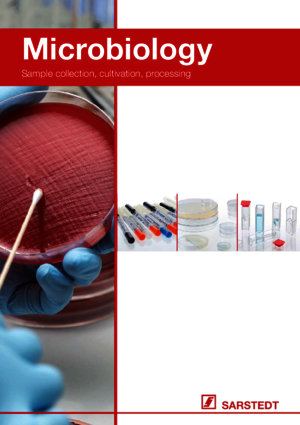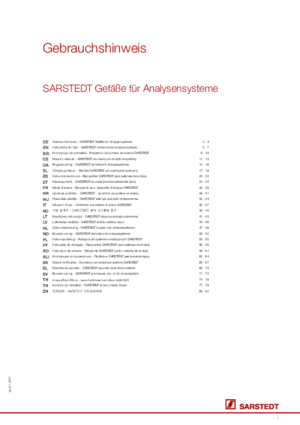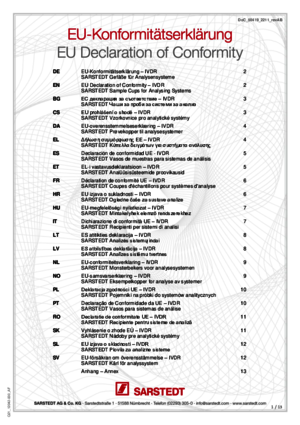
Microbiology
Microbiology
Language:
Since the 1970s we have been a well-known manufacturer of high-quality disposable cuvettes made from polystyrene (PS) and acrylic (PMMA). The cuvettes are also available as a 2x optical semi-micro cuvette and as a 4x optical cuvette for 90° angle fluorescence measurements. In order to capture the increasingly important UV range up to 220 nanometres (nm), the product range has been expanded to include UV transparent disposable cuvettes.

UV cuvette, max. working volume: 2.7 ml, material: special plastic, transparent, (HxW): 45 x 12.5 mm, optical sides: 2, suitable for use beginning at 220 nm, path length: 10 mm, centre height: 8.5 mm, sorted by mould cavity number, free from DNA/RNase/protein, 100 piece(s)/polystyrene container

UV cuvette, max. working volume: 2 ml, material: special plastic, transparent, (HxW): 45 x 12.5 mm, optical sides: 2, suitable for use beginning at 220 nm, path length: 10 mm, centre height: 15 mm, sorted by mould cavity number, 100 piece(s)/polystyrene container

UV cuvette, max. working volume: 2 ml, material: special plastic, transparent, (HxW): 45 x 12.5 mm, optical sides: 2, suitable for use beginning at 220 nm, path length: 10 mm, centre height: 15 mm, sorted by mould cavity number, free from DNA/RNase/protein, 100 piece(s)/polystyrene container
UV cuvette, max. working volume: 2.7 ml, material: special plastic, transparent, (HxW): 45 x 12.5 mm, optical sides: 2, suitable for use beginning at 220 nm, path length: 10 mm, centre height: 8.5 mm, sorted by mould cavity number, 100 piece(s)/polystyrene container
Semi-micro cuvette, max. working volume: 3 ml, material: PS, transparent, (HxW): 45 x 12 mm, optical sides: 2, path length: 10 mm, 500 piece(s)/bag
Semi-micro cuvette, max. working volume: 3 ml, material: PS, transparent, (HxW): 45 x 12 mm, optical sides: 2, path length: 10 mm, sorted by mould cavity number, 100 piece(s)/polystyrene container
Semi-micro cuvette, max. working volume: 3 ml, material: PMMA, transparent, (HxW): 45 x 12 mm, optical sides: 2, path length: 10 mm, sorted by mould cavity number, 100 piece(s)/polystyrene container
Cuvette, max. working volume: 4.2 ml, material: PS, transparent, (HxW): 45 x 12 mm, optical sides: 2, suitable for use beginning at 330 nm, path length: 10 mm, 500 piece(s)/bag
Cuvette, max. working volume: 4.2 ml, material: PS, transparent, (HxW): 45 x 12 mm, optical sides: 2, suitable for use beginning at 330 nm, path length: 10 mm, sorted by mould cavity number, 100 piece(s)/polystyrene container
Cuvette, max. working volume: 4.2 ml, material: PMMA, transparent, (HxW): 45 x 12 mm, optical sides: 2, suitable for use beginning at 300 nm, path length: 10 mm, sorted by mould cavity number, 100 piece(s)/polystyrene container

Our 80.625 swab cannot be autoclaved. The tube in the swab is made out of the autoclavable plastic polypropylene, but both the cap (polyethylene) and the swab stem (polystyrene) are not autoclavable. This is due to the low temperature resistance of the PE and PS plastic, which have a maximum long-term use temperature of 60–80°C. Autoclaving is carried out at temperatures of at least 121°C and it is not possible to rule out an impairment of the product as a result of this.
The distance between the base of the cuvette and the centre of the photometer light beam is defined as the centre height (Z). The centre height can vary depending on the manufacturer and the type of photometer, which is why Sarstedt offers UV cuvettes in two different centre heights (Z = 8 mm and Z = 15 mm). If customers do not know the exact centre height of the photometer, this information can be requested from the device manufacturer.
Fluorescence measurements are carried out at a 90° angle to the direction of the photometer beam and can therefore only be used in quadruple optical cuvettes. We offer a quadruple optical cuvette made of polystyrene (67.754) or PMMA (67.755) especially for this application.
Thanks to their optical properties, our polystyrene cuvettes can be used from the visual range to the UV range to 330 nanometres (nm). In contrast to this, acrylic (PMMA) cuvettes are characterised by a high level of transparency in the UV range and can therefore be used to approximately 300 nm. The plastic material of the UV cuvette enables measurements in the UV range from a wavelength of 220 nm.

